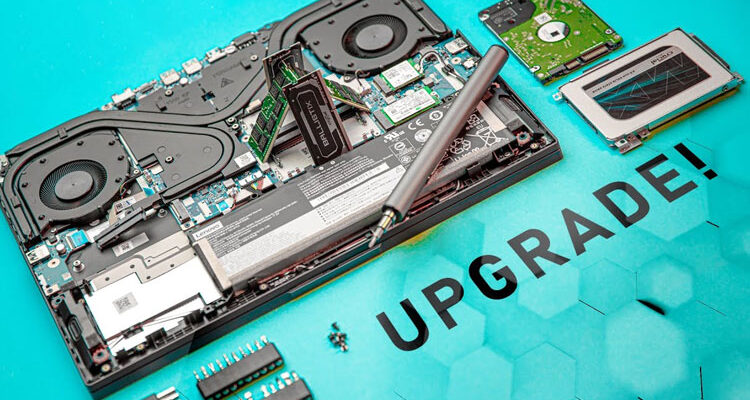Laptop computers are significantly less customizable than desktop computers due to their small size. On a laptop, you can usually update three things: the RAM memory, the hard disc, and the video/sound cards. This article will walk you through the main processes to upgrading a laptop, but if you get lost, consult your computer manufacturer’s instructions.
1. Getting the Memory Specifications for a Laptop
- Look for the make and model number of your laptop.
The manufacturer, make, and model number of a laptop are frequently printed on the laptop itself. The manufacturer and model number is usually placed on the bottom of the laptop, although it is also occasionally printed on the interior of the laptop above the keyboard.
- Locate the laptop’s instruction manual.
Type the manufacturer, make, and model number of your laptop into a search engine, followed by manual. You’ll find a link to the handbook itself or a page on the laptop manufacturer’s website where you can download the manual or maintenance guide among the search results.
You may also acquire your laptop’s handbook or maintenance guide directly from the manufacturer’s website. Download the laptop’s repair and maintenance handbook if one is available, since it will provide thorough information on the precise hardware you may use to improve your laptop.
- Determine how much RAM is being used by your Windows Vista or Windows 7 laptop.
Right-click Computer, then choose Properties from the Start menu. Installed memory (RAM) reveals how much memory you have installed in the System section.
- Determine how much RAM is being used by your Windows 8 laptop.
Right-click My Computer on the desktop, then choose Properties. Installed memory (RAM) reveals how much memory you have installed in the System section.
- Find out how much memory your Mac notebook has.
Then select About This Mac from the Apple menu. Memory reveals how much RAM you have installed in the About This Mac panel.
- Check to see if you have the maximum amount of RAM.
Check the system parameters in the laptop documentation you obtained to verify if you’re already utilizing the maximum RAM.
2. Upgrading Your Laptop’s RAM Memory
Most laptops allow users to update their RAM or memory by inserting a flash drive into a slot.You can buy fresh memory for your computer from an authorized dealer or the computer accessories shop directly. Third-party manufacturers occasionally provide memory sticks that are compatible with a wide range of laptops.
- Find out what sort of RAM your laptop has.
Look for the section on memory modules in the laptop handbook you downloaded. There are programs available that will show you the proper RAM for a given make and model of laptop if you can’t locate the information in the laptop handbook. An example of one of these tools may be found here.
- Purchase the RAM you require.
You may get the RAM you need from a variety of sources. Once you’ve decided on the sort of RAM you want to buy, put it into a search engine, and then select an internet retailer where you’d want to buy it.
Find out what sort of RAM your laptop has.
3. Consider updating the hard drive in your laptop.
Most manufacturers allow you to replace your existing hard disc with one that offers larger storage. The amount you spend will be determined by the amount of space you require. A 480GB SSD may easily approach $400 or $500, whereas a 1TB traditional hard disc can cost as little as $50 or $100. You’ll generally be able to locate a compartment that houses the hard drive in laptops that make it easy to replace the hard disc. For many users, an external hard drive is appealing since it may be launched by simply plugging it into a USB connection.
4. Upgrade to a newer operating system.
In most circumstances, upgrading to the current operating system does not necessitate purchasing a whole new laptop. Yes, newer operating systems come standard on more current laptops, but the upgraded system can usually be installed with little work on your part.
If your laptop is still running Windows 8 and you want to upgrade to Windows 10, for example, you’ll need to delete Windows 8 from your hard drive and download the newer version. Confirm the download if you have the necessary space. You may not have enough RAM to support the upgrade in some instances. If you require additional RAM, you should be able to do it without difficulty.
5. Your graphics card should be upgraded.
Many individuals want to know how to update their laptop graphics card (GPU), usually for gaming purposes. Your GPU, like your CPU, is usually soldered to your motherboard, making it impossible to replace.
Surprisingly, you may improve your graphics capabilities by purchasing an additional gadget that attaches to your USB connection. You’ll receive better graphics output, allowing you to use a second display in addition to your laptop screen.
6. If you wish to add a CD/DVD drive to your computer
Because CDs aren’t as popular as they once were because of streaming, most contemporary laptops don’t include a built-in disc drive.
You may buy an external optical drive if you want to play a favorite game from a few years ago or view a DVD every now and again. It’s one of the simplest upgrades because all you have to do is connect the drive in through USB and you’re good to go.
Although upgrading your laptop isn’t always the simplest path to a better computing experience, most of these recommendations are simple to do on your own, as we’ve described below. A desktop computer may be your best pick if you’re searching for a machine that can be customized, especially when it comes to gaming. However, if you only need extra RAM or storage space for your data, there are simple ways to do so with your laptop.




